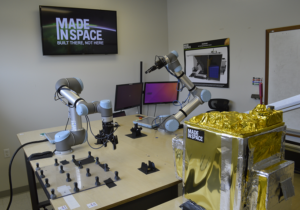Made In Space Successfully Manufactures First Extended 3D Printed Objects in a Space-Like Environment
 In 2015, space manufacturing company Made In Space revealed that it had completed successful tests that indicated that its newest generation of 3D printers would be fully functional in the vacuum of open space. Today, the company announced that it recently manufactured the first-ever extended 3D printed objects in a space-like environment. This exciting achievement means that Made In Space is well on its way to manufacturing satellites and systems in the vacuum of space.
In 2015, space manufacturing company Made In Space revealed that it had completed successful tests that indicated that its newest generation of 3D printers would be fully functional in the vacuum of open space. Today, the company announced that it recently manufactured the first-ever extended 3D printed objects in a space-like environment. This exciting achievement means that Made In Space is well on its way to manufacturing satellites and systems in the vacuum of space.
The breakthrough comes as part of the company’s Tipping Point contract with NASA. It seems like only yesterday that Made In Space sent the Additive Manufacturing Facility up to the International Space Station, but it’s been over a year now – a year that’s been filled with all kinds of interesting projects and exciting announcements from the company.
Well on the way to fulfilling its mission of offering off-Earth manufacturing capabilities during space exploration, Made In Space has successfully operated its Extended Structure Additive Manufacturing Machine (ESAMM) within the unforgiving vacuum and temperature environment that’s found in outer space, at the NASA Ames Research Center‘s Engineering Evaluation Laboratory (EEL).
Andrew Rush, the President and CEO of Made In Space, said, “These successful demonstrations mean that on-demand, adaptable manufacturing of complex structures in space has been significantly derisked. This expands the design space. We hope that mission planners can now more confidently design missions around in-space manufacturing and assembly, optimizing satellites for their operational environment, not just launch.”
The structures that were built in NASA’s EEL TVAC facility were made using PEI/PC (polyetherimide/polycarbonate) polymer alloy, which is suitable for applications in space.
One of the key components of designing and deploying next-generation, space-optimized satellites is the ability to build large-scale, complex structures in a space environment, and Made In Space later built on the in-vacuum additive manufacturing success at NASA in its own facilities, manufacturing a beam structure of over 30 meters in length with its ESAMM hardware.
“Satellites incorporating in-space manufacturing and assembly will inherently be more capable and provide more value to operators and users. We’re proud to be making this vision a reality and grateful for NASA’s support,” said Rush.
ESAMM is also used to build space-optimized structures as parts of the company’s in-space manufacturing and assembly technology, Archinaut, which combines ESAMM with robotic assembly; NASA enlisted Made In Space to help develop Archinaut back in 2015. It’s a multi-armed machine used to build larger, more complex structures than any others currently in space, and will eventually be installed on an external space station pod in order to take care of in-orbit additive manufacturing, as well as fabricating and assembling communications satellite reflectors and repairing machinery and structures in space. Because Archinaut manufactures in outer space, it allows for structures and spacecraft to be optimized for the environment of space, and not the launchpad on Earth.
Made In Space also used PEI/PC to manufacture a structural segment of a space-optimized boom on its ISS 3D printer. Both of these tests are a clear demonstration of ESAMM’s “high state of technological readiness.”
What do you think about this exciting announcement? Let us know in the Made In Space forum thread at 3DPB.com.
[All Images: Made In Space]
Subscribe to Our Email Newsletter
Stay up-to-date on all the latest news from the 3D printing industry and receive information and offers from third party vendors.
You May Also Like
3D Printing Financials: Protolabs’ Q1 3D Printing Revenue is Flat, Company Advances in Technology Push
Protolabs (NYSE: PRLB) has kicked off 2024 with a mild boost in revenue, revealing how the Minnesota-based company manages to adapt and thrive even in uncertain market conditions. While the...
NASA Backs Project for 3D Printing Space Sensors
NASA granted $300,000 to Florida State University (FSU) and Florida Agricultural and Mechanical University (FAMU) to pioneer a project using 3D printing to develop cutting-edge sensors capable of withstanding the...
Further Understanding of 3D Printing Design at ADDITIV Design World
ADDITIV is back once again! This time, the virtual platform for additive manufacturing will be holding the first-ever edition of ADDITIV Design World on May 23rd from 9:00 AM –...
Daring AM: Rocket Lab Shoots for the Stars, Astrobotic Wants to 3D Print on the Moon
Once again, space exploration teams up with the 3D printing industry, launching projects that could change how we explore space. Pioneering space manufacturer Rocket Lab (Nasdaq: RKLB) secured a $14.49...




































